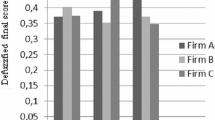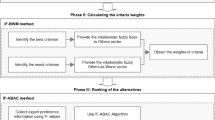Abstract
Blue ocean strategy is a new approach to strategy-making and innovation with the aim of sustained performance and growth of the company. In this approach, an analytical and decision-making tool known as Strategy Canvas is introduced in order to create blue oceans and to innovate value. Strategy Canvas provides a basic framework for taking into account all competitive and key factors in the current industry. In this study, the proposed fuzzy best–worst method is employed as a multi-criteria decision-making method to map Strategy Canvas of a manufacturing company in Iran. The proposed method is concerned with the proposition of a new approach to eliciting the weight vector from the fuzzy pairwise comparison matrices. For this purpose, a nonlinear optimization model was proposed. After solving the model, crisp weights were extracted from the fuzzy pairwise comparison matrices. The proposed method was an execution of the best–worst method in a fuzzy environment. This method is able to carry out fewer and more consistent comparisons. This method is also capable of substituting the fuzzy AHP method.







Similar content being viewed by others
References
Bellman, R. E., & Zadeh, L. A. (1970). Decision-making in a fuzzy environment. Management Science, 17(4), B-141.
Bernoulli, D. (1738). Specimen Theoriae Novae de Mensura Sortis. Commentarri Academiae Scientiarum Imperialis Petropolitanae, 5, 175–192.
Bourletidis, D. (2014). The strategic model of innovation clusters: Implementation of blue ocean strategy in a typical Greek region. Procedia-Social and Behavioral Sciences, 148, 645–652.
Brans, J. P., & Vincke, P. (1985). A preference ranking organization method. Management Science, 31(6), 647–656.
Brauers, W. K. M., Zavadskas, E. K., Turskis, Z., & Vilutiene, T. (2008). Multi-objective contractor’s ranking by applying the Moora method. Journal of Business Economics and Management, 9(4), 245–255.
Buckley, J. J. (1985). Fuzzy hierarchical analysis. Fuzzy Sets and Systems, 17(3), 233–247.
Chang, D.-Y. (1996). Applications of the extent analysis method on fuzzy AHP. European Journal of Operational Research, 95(3), 649–655.
Chang, S.-C. (2010). Bandit cellphones: A blue ocean strategy. Technology in Society, 32(3), 219–223.
Cheng, C.-H. (1997). Evaluating naval tactical missile systems by fuzzy AHP based on the grade value of membership function. European Journal of Operational Research, 96(2), 343–350.
Cheng, C.-H. (1999). Evaluating weapon systems using ranking fuzzy numbers. Fuzzy Sets and Systems, 107(1), 25–35.
Dubois, D. J. (1980). Fuzzy sets and systems: Theory and applications (Vol. 144). Cambridge: Academic Press.
Hollensen, S. (2013). The Blue Ocean that disappeared–the case of Nintendo Wii. Journal of Business Strategy, 34(5), 25–35.
Hwang, C.-L., & Yoon, K. (1981). Methods for multiple attribute decision making. In Multiple attribute decision making (pp. 58–191). Springer.
Kamal, A. H., & Dionne-Odom, J. N. (2016). A Blue Ocean strategy for palliative care: Focus on family caregivers. Journal of Pain and Symptom Management, 51(3), e1–e3.
Kauffman, A., & Gupta, M. M. (1991). Introduction to fuzzy arithmetic, theory and application. New York: Van Nostrand Reinhold.
Keeney, R. L., & Raiffa, H. (1993). Decisions with multiple objectives: Preferences and value trade-offs. Cambridge University Press.
Keršuliene, V., Zavadskas, E. K., & Turskis, Z. (2010). Selection of rational dispute resolution method by applying new step-wise weight assessment ratio analysis (SWARA). Journal of Business Economics and Management, 11(2), 243–258.
Keshavarz Ghorabaee, M., Zavadskas, E. K., Olfat, L., & Turskis, Z. (2015). Multi-criteria inventory classification using a new method of evaluation based on distance from average solution (EDAS). Informatica, 26(3), 435–451.
Kickert, W. J. M. (1979). Fuzzy theories on decision making: A critical review (Vol. 3). Berlin: Springer Science & Business Media.
Kim, W. C., & Mauborgne, R. (2005). Blue ocean strategy: From theory to practice. California Management Review, 47(3), 105–121.
Kumar, A., & Dash, M. K. (2017). Using fuzzy Delphi and generalized fuzzy TOPSIS to evaluate technological service flexibility dimensions of internet malls. Global Journal of Flexible Systems Management, 18(2), 153–161.
Lindič, J., Bavdaž, M., & Kovačič, H. (2012). Higher growth through the blue ocean strategy: Implications for economic policy. Research Policy, 41(5), 928–938.
Mikhailov, L. (2003). Deriving priorities from fuzzy pairwise comparison judgements. Fuzzy Sets and Systems, 134(3), 365–385.
Opricovic, S. (1998). Multicriteria optimization of civil engineering systems. Faculty of Civil Engineering, Belgrade, 2(1), 5–21.
Pawlak, Z. (1982). Rough sets. International Journal of Parallel Programming, 11(5), 341–356.
Pawlak, Z., & Słowinski, R. (1994). Decision analysis using rough sets. International Transactions in Operational Research, 1(1), 107–114.
Porter, M. E. (1990). The competitive advantage of nations. Harvard Business Review, 68(2), 73–93.
Rebón, F., Ocariz, G., Gerrikagoitia, J. K., & Alzua-Sorzabal, A. (2015). Discovering insights within a blue ocean based on business intelligence. Procedia-Social and Behavioral Sciences, 175, 66–74.
Rezaei, J. (2015). Best-worst multi-criteria decision-making method. Omega, 53, 49–57.
Roy, B. (1968). Classement et choix en présence de points de vue multiples. Revue Française d’informatique et de Recherche Opérationnelle, 2(8), 57–75.
Roy, B. (1971). Problems and methods with multiple objective functions. Mathematical Programming, 1(1), 239–266.
Roy, B. (1978). ELECTRE III: Un algorithme de classement fondé sur une représentation floue des préférences en présence de critères multiples. Cahiers Du CERO, 20(1), 3–24.
Roy, B., & Bertier, P. (1973). La Méthode ELECTRE II(Une application au média-planning...).
Ruoning, X., & Xiaoyan, Z. (1996). Fuzzy logarithmic least squares ranking method in analytic hierarchy process. Fuzzy Sets and Systems, 77(2), 175–190.
Saaty, T. L. (1972). An eigenvalue allocation model for prioritization and planning. In Energy management and policy center, University of Pennsylvania (pp. 28–31).
Saaty, T. A. (1992). Decision-making for leaders (2nd ed.). Pittsburgh: RWS Publication.
Saaty, T. L. (1996). The analytic network process. Pittsburgh: RWS Publications.
Sharma, V., Seth, P., & Niyazi, S. (2012). Blue Ocean strategy: A vehicle for entrepreneurship. Advancing technologies for Asian business and economics: information management developments (p 198).
Shojaie, A. A., Babaie, S., Sayah, E., & Mohammaditabar, D. (2018). Analysis and prioritization of green health suppliers using Fuzzy ELECTRE method with a case study. Global Journal of Flexible Systems Management, 19(1), 39–52.
Sushil. (2017). Small steps for a giant leap: Flexible organization. Global Journal of Flexible Systems Management, 18(4), 273–274. https://doi.org/10.1007/s40171-017-0163-7.
Sushil. (2018). Interpretive multi-criteria ranking of production systems with ordinal weights and transitive dominance relationships. Annals of Operations Research. https://doi.org/10.1007/s10479-018-2946-4.
Sushil., & Chroust, G. (2014). Systemic flexibility and business agility. Berlin: Springer.
Van Laarhoven, P. J. M., & Pedrycz, W. (1983). A fuzzy extension of Saaty’s priority theory. Fuzzy Sets and Systems, 11(1), 199–227.
Von Neumann, J., & Morgenstern, O. (1947). Theory of games and economic behavior, 2nd rev.
Von Neumann, J., & Morgenstern, O. (2007). Theory of games and economic behavior. Princeton: Princeton University Press.
Wang, Y.-M., & Chin, K.-S. (2008). A linear goal programming priority method for fuzzy analytic hierarchy process and its applications in new product screening. International Journal of Approximate Reasoning, 49(2), 451–465. https://doi.org/10.1016/j.ijar.2008.04.004.
Wang, Y.-M., Elhag, T. M. S., & Hua, Z. (2006). A modified fuzzy logarithmic least squares method for fuzzy analytic hierarchy process. Fuzzy Sets and Systems, 157(23), 3055–3071.
Wang, L., Chu, J., & Wu, J. (2007). Selection of optimum maintenance strategies based on a fuzzy analytic hierarchy process. International Journal of Production Economics, 107(1), 151–163.
Wang, Y.-M., & Chin, K.-S. (2011). Fuzzy analytic hierarchy process: A logarithmic fuzzy preference programming methodology. International Journal of Approximate Reasoning, 52(4), 541–553.
Xu, X. (2001). The SIR method: A superiority and inferiority ranking method for multiple criteria decision making. European Journal of Operational Research, 131(3), 587–602.
Yang, J. (2012). Identifying the attributes of blue ocean strategies in hospitality. International Journal of Contemporary Hospitality Management, 24(5), 701–720.
Zadeh, L. A. (1965). Fuzzy sets. Information and Control, 8(3), 338–353.
Zavadskas, E. K., & Turskis, Z. (2010). A new additive ratio assessment (ARAS) method in multicriteria decision-making. Technological and Economic Development of Economy, 16(2), 159–172.
Zavadskas, E. K., Kaklauskas, A., & Sarka, V. (1994). The new method of multicriteria complex proportional assessment of projects. Technological and Economic Development of Economy, 1(3), 131–139.
Zavadskas, E. K., Turskis, Z., Antucheviciene, J., & Zakarevicius, A. (2012). Optimization of weighted aggregated sum product assessment. Elektronika Ir Elektrotechnika, 122(6), 3–6.
Zimmermann, H. J. (1985). Fuzzy set theory and its applications. International series in management science/Operations research. Dordrecht: Kluwer-Nijhoff Publishing.
Zimmermann, H.-J. (2012). Fuzzy sets, decision making, and expert systems (Vol. 10)). Berlin: Springer Science & Business Media.
Author information
Authors and Affiliations
Corresponding author
Ethics declarations
Conflict of interest
The authors declared that they have no conflicts of interest.
Appendix
Appendix
Theorem 1
The priorities derived by the LFPP methodology from the upper triangular elements of a fuzzy pairwise comparison matrix are exactly the same as those derived from the lower triangular elements of the fuzzy pairwise comparison matrix (Wang and Chin 2011).
Theorem 2
The LFPP methodology produces the unique normalized optimal priority vector for any fuzzy pairwise comparison matrix (Wang and Chin 2011).
Theorem 3
FBW measures a unique normalized optimal priority vector.
Proof
The FBW’s objective function is a convex function, and the constraints of the model are linear. Hence, the feasible area is also convex. The optimal solution is often unique and the model presents unique weights based on the convex programming theory.
Theorem 4
The proposed FBW method ends in a more compromised and better solution compared with LFPP method for weighting the criteria or alternatives in a fuzzy pairwise comparison with lower calculations and comparisons. The optimal solution of FBW is, in other words, less than or equal to the optimal solution of LFPP.
Proof
To avoid complexity, the worst criterion is set in the first position (W = 1) and the best at the last position (B = n) of the pairwise comparison.
\(\tilde{A}\) | \(C1 = C_{\text{w}}\) | \(C_{j}\) | \(Cn = C_{\text{B}}\) |
|---|---|---|---|
\(C1\) | \(1\) | \(\_\) | \(\_\) |
\(C_{i}\) | The worst comparison:\(\tilde{\varvec{a}}_{{\varvec{iw}}}\) | The other comparison:\(\left[ {\tilde{\varvec{a}}_{{\varvec{ij}}} } \right]\) | \(\_\) |
\(Cn = C_{\text{B}}\) | \(\tilde{\varvec{a}}_{{\varvec{Bw}}}\) | The best comparison:\(\tilde{\varvec{a}}_{{\varvec{Bj}}}\) | \(1\) |
Applying Theorem 1, no variation is created whether the elements under the main diagonal of a fuzzy pairwise comparison matrix are considered or those above. The elements below are considered, and the LFPP model is rewritten by FWB notation:
Based on Theorem 2, by solving Model (17), the optimal solution \(x_{\text{LFPP}}^{ *}\) is computed. The FBW model has been rewritten again.
Assuming the comparisons’ decrease in FBW model, the model constraints also declined. Solving Model (18), the only global optimal solution \(x_{\text{FBW}}^{ *}\) is calculated considering Theorem 3. The possible areas of Models (17 and 18) are, respectively, called \(S_{\text{LFPP}}\) and \(S_{\text{FBW}}\).
The solution area is expanded with the decrease of model constraints. This expansion ends in two various results: The expansion does not affect the objective function value or decrease the objective function value (minimum OB). Thus, the FBW model value is equal to or lower when compared with the optimal solution of LFPP model expressed as follows:
The FBW’s value of the objective function is constantly lower in comparison with the LFPP’s. On the other hand, the positive term \(\mathop \sum \limits_{{j \in k^{{{\prime \prime \prime }}} ,\;j \le n - 1}} \mathop \sum \limits_{{i \in k^{{{\prime \prime \prime }}} ,i > j}} \left( {\delta_{ji}^{2} + \eta_{ji}^{2} } \right)\) in the LFPP’s objective function is greater than the objective function of FBW method. Accordingly, given this value, LFPP model’s response is worse compared with FBW model.
Rights and permissions
About this article
Cite this article
Khanmohammadi, E., Zandieh, M. & Tayebi, T. Drawing a Strategy Canvas Using the Fuzzy Best–Worst Method. Glob J Flex Syst Manag 20, 57–75 (2019). https://doi.org/10.1007/s40171-018-0202-z
Received:
Accepted:
Published:
Issue Date:
DOI: https://doi.org/10.1007/s40171-018-0202-z




